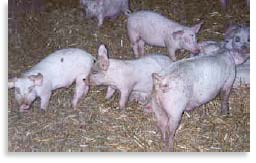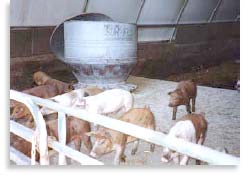 |
 |
||||||||||||||||||||||||||||||||||
|
|
|||||||||||||||||||||||||||||||||||
 |
|||||||||||||||||||||||||||||||||||
|
Swedish Deep Straw Farrowing
A variety of buildings can be used in the Swedish deepstraw system, including old hog houses, barns or even hoop structures. Older buildings should be well insulated and must be well ventilated and well lit, using both natural and artificial light, to help ensure that pigs respond to the light cycles of day and night. Piglets are kept in the farrowing boxes for their first seven to ten days, allowing them to bond with their mother. Then the farrowing boxes are removed and the sows and litters are allowed to mingle (Halverson et al., 1997). During this period, they have free access to a common area that includes feed and water on a raised platform. After weaning, the sows are taken to a breeding barn or room while the pigs stay in the nursing room. For a nursing room with eight to ten sows, a farmer spreads two 750-pound round bales of straw before animals enter the area. The farmer adds another 750-pound bale of straw to the room every week and places fresh straw over wet spots daily. The minimum amount of space needed for this system is about 27 square feet per sow during gestation and mating phases and 81 square feet per sow and litter during nursing (Halverson et al., 1997). Throughout the farrowing process, sows are maintained in groups of 8 to 12, and sows within a group are bred to farrow within five days of one another to minimize size differences among their piglets. The composting component of this system is key to good animal health. In Sweden, sow longevity is between six and seven farrowings compared with about three farrowings for hogs raised in confinement in the United States (Halverson et al., 1997). Increased sow longevity means fewer replacement sows and reduced costs. The larger litters that older sows successfully farrow and wean also improve the bottom line. Deep-straw bed farrowing operations require an average of 18 hours of labor per sow per year (Halverson et al., 1997). A new producer can expect to put in more hours as both producer and hogs learn how to operate in this new system. Deep Straw Hoop Structures
Hoop structures generally cost less and require less maintenance than more traditional confinement structures. They are quick and easy to build and can be used for other things when hog prices are down. Because the manure generated in hoop structures is in a solid form, the potential for odor and water contamination are minimized. Most hoop structures used in the Midwest are 30 feet by 72 feet and house 180 finishing pigs (Brumm et al., 1997). Eight big round bales (approximately 1,200 pounds each) of straw or cornstalk bedding are put down and one or two 1,200-pound bales are added each week (Brumm et al., 1997). It is important to have enough bedding material and to cover wet spots. Building costs, including cement and waterers, range from $9,000 to $16,200, depending on the manufacturer and how much work is hired out. At $50 to $90 per pig space, this represents approximately one-quarter to one-half the cost per pig space of standard confinement facilities (Brumm et al., 1997). Average daily gain for hoop-housed pigs is as good as that of confinement pigs, and may be greater (Brumm et al., 1997). Research has shown that feed efficiency drops during the winter. While labor is highly variable depending on farm size, experience of the manager, etc., some studies show that the hoop house system requires slightly more labor (0.1 hour per pig) than confinement systems (Duffy and Honeyman, 2000). With hoop structures, more time is spent checking pigs, moving and arranging large bales of bedding, and loading and hauling solid manure (Honeyman et al., 2000). More time is needed for observation and monitoring of conditions such as temperature and bedding level (Honeyman et al., 2000). With the hoop structure system, manure and urine are mixed with large amounts of carbonaceous material and composted year-round. The composting process stabilizes the nutrients and reduces the volume of wastes. Because the manure is in a stabilized solid form, the danger of run-off and other environmental hazards can be reduced, although there may be some concern about nitrogen leaching from manure packs which are stored outdoors until they can be spread, especially during high rainfall periods (Richard et al., 1997). Odor is also minimized, if not totally eliminated. Pasture Production Systems
Electric fencing is often used in pasture farrowing because it is easy to install, remove and store. Fencing can divide a pasture into groups of sows with pigs the same age, which is advantageous during group lactation (Honeyman and Weber, 1996). In most cases, pastures can be established or removed in less than an hour. These technologies give producers control over livestock without the extensive fence maintenance of older woven-wire hog fences. In a pasture system, feed accounts for 60 to 70 percent of the total cost of producing hogs farrow to finish (Honeyman and Weber, 1996). A study of Iowa farm records from 1989 to 1993 found that outdoor farrowing herds required 20.6 pounds more feed per hundred-weight of live gain (or 51.5 pounds more feed per 250-pound pig marketed) than indoor farrowing herds. In pasture farrowing, each acre typically has 7 to 15 sows and litters. One of the best things about the pasture system is the healthy environment it offers both animals and producers. Respiratory diseases, rhinitis and foot and leg problems are minimized in hogs allowed outside (Gegner, 1992). Producers using pasture farrowing often have lower swine health expenses than producers using confinement systems, because less disease is transmitted in open spaces (Honeyman and Weber, 1996).
*The text of this two page section is excerpted from "Hogs Your Way", Copyright © 2001, Regents of the University of Minnesota. University of Minnesota Extension Service, 405 Coffey Hall, St. Paul, MN 55108-6068. (800) 876-8636.
If you have any thoughts on this or would like to contribute to an ongoing discussion in the
E-mail, Opinions & Discussion column click here to send e-mail to publish@inmotionmagazine.com.  Hot Topics || Region || Affirmative Action || What is New? || Education Rights || Art Changes || Rural America || Essays from Ireland || Autonomy: Chiapas - California || En español || Healthcare || Global Eyes || Piri Thomas || Photo of the Week || E-mail, Opinions and Discussion In Motion Staff || CD's In Motion || In Unity Book of Photos || NPC Productions || Links Around The World |
|||||||||||||||||||||||||||||||||||



